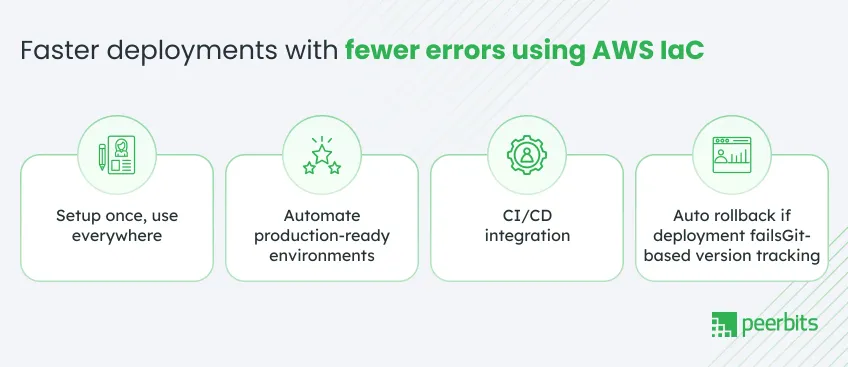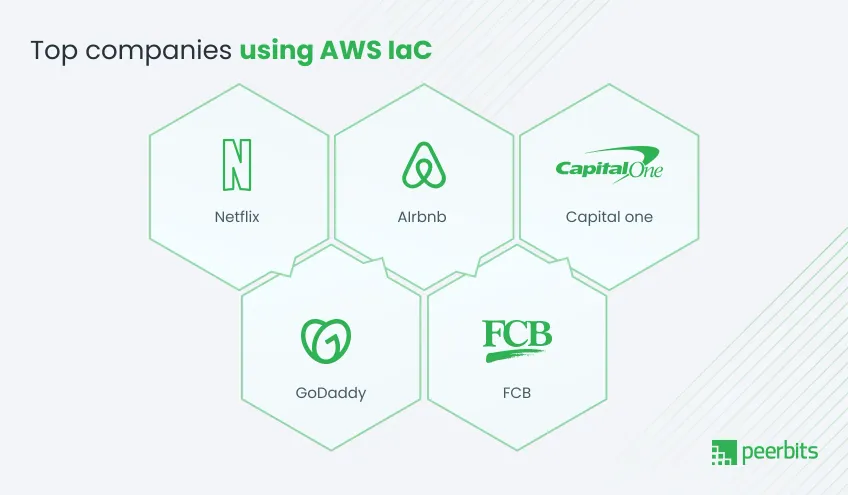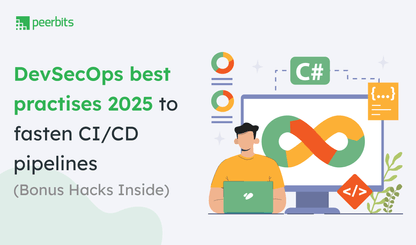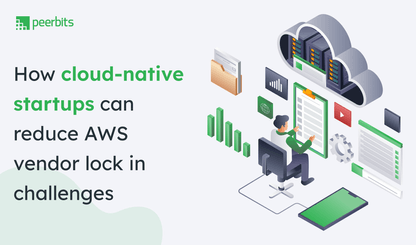Setting up cloud infrastructure manually might work when you're experimenting. But once you are managing production workloads, growing environments, or distributed teams, manual provisioning becomes a serious hassle. Configuration drift, deployment delays, and inconsistent environments all slow you down.
At this stage, AWS Infrastructure as Code (IaC) helps teams bring consistency to cloud setup and delivery. Instead of clicking through the console, teams can define infrastructure using code, making it easy to test, reuse, and deploy across multiple stages.
Whether you are using AWS CloudFormation or the AWS CDK, each tool helps reduce risk and speed up delivery.
For businesses building on AWS cloud computing services, this shift to infrastructure as code is about convenience and how they achieve stable, scalable deployments without constant hustling through different servers.
Let’s understand Amazon Infrastructure as Code from the start and assess important AWS IaC tools you need, with detailed insights on hiring the best AWS IaC developers.
What is AWS Infrastructure as Code (IaC)?
AWS Infrastructure as Code (IaC) is a way to define, manage, and provision your cloud resources using configuration files instead of relying on manual clicks. With this, developers can write infrastructure setups in code, making them easy to version, test, and reuse across environments.
With Amazon infrastructure as code, everything from network settings to compute resources can be documented and executed through scripts. This reduces human error, shortens deployment time, and helps teams maintain consistent setups from development to production.
Using AWS Infrastructure as Code means you are writing templates and building repeatable, reliable environments with tools customized for AWS. Among the most widely used IaC tools for AWS are:
- AWS CloudFormation: AWS-native template-driven provisioning
- AWS CDK Infrastructure as Code: a developer-friendly option using real programming languages like TypeScript, Python, or Java
Each tool brings its own strengths, but they all support the same outcome: fast, consistent, and trackable infrastructure delivery. We will be covering this later ahead.
This shift toward treating infrastructure like software has made AWS CloudFormation IaC and CDK-based setups a standard for teams building serious cloud systems.
Why IaC matters for cloud teams & business growth?
Fast-moving teams rely on solid infrastructure. But without automation in place, even well-designed setups often hit scaling issues. As your AWS cloud architecture expands, manual work starts creating friction, especially across teams, environments, and regions.
Here, Infrastructure as Code on AWS helps in solving common blockers that slow down delivery:
-
Error-prone manual tasks: Repeating setups manually increases the risk of misconfigurations and outages. IaC reduces human dependency by turning cloud setup into tested, versioned code.
-
Time-consuming environment recreation: Rebuilding a staging or QA environment manually takes hours. With IaC, it takes minutes and the results stay consistent across every deployment.
-
Developer onboarding delays: New team members shouldn’t spend their first week asking for credentials or digging through setup guides. IaC scripts make it simple to spin up a ready-to-use environment.
-
Drift between dev, test, and prod: Differences in environments often lead to bugs that never showed up in testing. IaC maintains alignment, reducing surprises during production rollouts.
-
Lack of visibility into infrastructure changes: When changes are made manually, no one really knows what changed or when. With IaC, changes are tracked in version control, creating a clear audit trail.
For any team looking to scale cloud operations, the benefits of Infrastructure as Code go beyond speed. It helps standardize delivery, improve security posture, and remove repeated manual work. That’s why many teams are rethinking how they automate AWS infrastructure to support long-term growth.
AWS IaC tools: Overview
Choosing the right tool depends on how your team works and how much flexibility you need. Each option offers different IaC benefits, from developer control to deep AWS integration. Here’s a quick comparison to help you understand what fits best for your workflow.
| Tool | Type | Highlights |
|---|---|---|
| AWS CloudFormation | Native AWS tool (declarative) | Good for deep AWS integration, stable, and widely supported |
| AWS CDK | Uses real programming languages | Dev-friendly, supports TypeScript, Python, Java, allows logic in infra code |
Each of these IaC tools for AWS supports different levels of abstraction and team needs. Some prefer AWS CloudFormation IaC for its native alignment with AWS services. Dev teams looking for code-driven workflows often lean toward the AWS CDK Infrastructure as Code.
Choose the right AWS IaC tool for your business
The best IaC tool is what fits your current team, infrastructure, and growth plans. Each of the major AWS Infrastructure as Code tools brings different strengths to the table.
Here’s a quick breakdown to guide your choice:
-
AWS CloudFormation: Best suited for teams deeply invested in the AWS ecosystem. It’s stable, well-integrated, and follows AWS-native standards. Ideal for organizations prioritizing long-term consistency.
-
AWS CDK (Cloud Development Kit): A go-to for developer-driven teams that want to use familiar programming languages like TypeScript, Python, or Java. If your team already writes infrastructure logic into your pipelines, AWS CDK development might feel like a natural fit.
Your decision depends on factors like internal skill sets, how your infrastructure is currently managed, and whether you need cross-cloud support. All three tools support modern IaC workflows, but choosing the right one can make long-term management simpler and more efficient.
How AWS IaC speeds up deployments and cuts errors?

Once you define your infrastructure as code, you don’t have to repeat the setup process again and again. Whether you're launching a new dev environment or spinning up production workloads, AWS IaC deployment brings consistency, speed, and reduced risk to the process.
Here’s how teams use IaC to move faster without breaking things:
-
Setup once, use everywhere: Templates and scripts can be reused across projects, regions, and environments. A well-written setup becomes your internal blueprint—tested and ready to scale.
-
Automate production-ready environments: Everything from networking to security groups can be pre-approved and codified. This eliminates surprises during go-live and follows AWS IaC best practices for safer releases.
-
CI/CD integration: IaC integrates tightly into CI/CD pipelines. As soon as code is committed, infrastructure changes can be reviewed, validated, and deployed automatically.
-
Auto rollback if deployment fails: Tools like CloudFormation and CDK support rollback mechanisms. If something fails, the environment rolls back to the last stable state.
-
Git-based version tracking: Infrastructure lives alongside application code in Git. Every change is traceable, auditable, and reversible, which improves control and accountability.
Teams using Infrastructure as Code on AWS consistently report fewer outages, faster provisioning, and less time spent fixing inconsistent setups. It is a kind of tech upgrade that helps businesses move from firefighting to predictable delivery.
Benefits of adopting AWS IaC for businesses
For teams growing on the cloud, Infrastructure as Code brings structure and repeatability to what can otherwise be a chaotic setup. When combined with the broader benefits of moving to AWS cloud like scalability, flexibility, and cloud managed services. It creates a foundation for confident, high-speed delivery.
Here’s what that means in day-to-day operations:
-
Predictable delivery timelines: Since setups are reusable and versioned, teams avoid last-minute surprises. This makes release schedules more accurate and dependable.
-
Lower downtime during changes: Rollbacks, automated validations, and consistent environments help reduce service disruptions. Most AWS IaC tools offer safety nets that catch issues before they hit production.
-
Easier handovers and developer transitions: With all infrastructure stored in code, new team members don’t need to reverse-engineer what was done. They get a clear, codified setup to build on.
-
Built-in documentation: Code becomes the single source of truth. Instead of relying on outdated diagrams or tribal knowledge, your cloud infrastructure as code setup doubles as always-current documentation.
-
Compliance and audit readiness: Teams following AWS IaC best practices can show who made what change, when, and why. Making it easier to pass audits or meet internal compliance standards.
The shift to Infrastructure as Code on AWS helps giving your team confidence, clarity, and control in how infrastructure supports business growth.
How top companies use AWS IaC to manage cloud infrastructure?

Many global brands rely on AWS Infrastructure as Code to support growth, manage complexity, and move faster with fewer risks. Here are some standout examples showing how real businesses apply AWS IaC deployment in everyday operations.
Netflix
How they used it: Netflix uses AWS CloudFormation IaC to automate resource provisioning across its massive microservices-based architecture. From EC2 instances to S3 buckets and ELBs, everything is managed as code. Tools like Spinnaker integrate with CloudFormation for fast, reliable deployments.
Benefits:
- Scalability: Handles sudden traffic surges during releases by dynamically scaling infrastructure.
- Reliability: Reduces manual errors and supports millions of users with consistent environments.
- Speed: Fast rollout of updates keeps up with their innovation cycles.
Airbnb
- How they used it: Airbnb combines CloudFormation and Terraform to manage cloud infrastructure across development, staging, and production. IaC controls resources like RDS, EC2, and EKS clusters.
Benefits:
- Consistency: Environments stay identical across all stages.
- Cost efficiency: Automates both provisioning and shutdown to avoid waste.
- Developer productivity: Frees up engineers from repetitive setup tasks.
Capital One
How they used it: Capital One adopted AWS CloudFormation Infrastructure as Code to modernize infrastructure for its financial products. They use IaC to manage resources like VPCs, S3, and Lambda with compliance baked in.
Benefits:
- Security and compliance: Codified guardrails and audit-ready change tracking.
- Agility: Faster deployment cycles support new customer features.
- Cost optimization: Dynamic resource scaling minimizes cloud spend.
GoDaddy
How they used it: GoDaddy moved from manual processes to full IaC automation using CloudFormation. They use it to manage hosting infrastructure like EC2 and S3, focusing on automation over operations.
Benefits:
- Time savings: Eliminated 100+ daily compute rotations, improving efficiency.
- Reliability: Reduced downtime by maintaining consistent environments.
- Scalability: Supports demand spikes in hosting services.
What to look for when hiring AWS IaC developers
As your infrastructure grows, so does the need for people who can manage it with structure and precision. When you're ready to get AWS cloud consulting services, look beyond tool knowledge. The right developer can help you build a scalable, secure, and maintainable cloud foundation.
Here’s what to look for:
-
Hands-on with major IaC tools: Candidates should be confident with CloudFormation and CDK. They should also understand where each tool fits based on business needs.
-
Experience with CI/CD and cloud security: IaC works best when tied into automated pipelines and security checks. Developers should know how to integrate infrastructure with safe deployment practices.
-
Scalable deployment experience: Look for real-world success in building production environments that scale reliably across regions and teams.
-
Familiarity with GitOps culture: Infrastructure should be tracked and managed like application code. A strong IaC developer will know how to work with Git workflows and peer-reviewed updates.
-
Ability to audit and refactor existing code: They should be comfortable reviewing existing infrastructure and applying AWS IaC best practices to improve performance, cost, and security.
The right developer will help you automate AWS infrastructure in a way that’s consistent, clean, and built to support long-term goals.
Conclusion
Running cloud systems at scale requires more than the right services. It depends on how your infrastructure is planned, deployed, and managed. AWS Infrastructure as Code helps teams bring consistency to cloud setup and delivery. Common automation scenarios include amazon s3 to postgresql data pipeline provisioning for scalable analytics infrastructure deployment.
From global platforms to internal systems, teams rely on IaC to reduce manual work, avoid errors, and create predictable deployments. The benefits of moving to AWS cloud become clear when infrastructure is written as code and tracked like application logic. This approach improves delivery speed and gives better control over resources.
With the right toolset, clear standards, and skilled developers, Infrastructure as Code on AWS supports both short-term efficiency and long-term growth.









